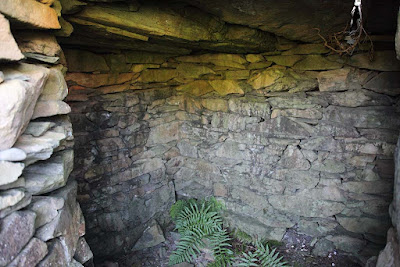
Last weekend it was neap tides on the Solway. HW here is always in early morning and evening with neaps and as the tide goes out a long way, mid day paddling is not possible from many of the bays.
I set off at 5pm on Sunday evening and crossed the mouth of Fleet Bay. I turned into Castle Haven Bay as I know of a wonderful historic site at its head. Castle Haven is passed by by most people. Its wall grow out of the Galloway rocks but have become overgrown by vegetation. It is a D shaped broch or dun. These double walled dry stone structures were built up the west coast of Scotland and the Hebrides in the final centuries BC. Castle Haven is the most southerly example.

Dun Carloway in Lewis is perhaps the most famous. As the sea was the highway of communication in those days it is likely that the owners of Castle Haven and Dun Carloway knew each other even though they are 420km apart as the sea eagle flies. Perhaps they were even on first name terms!

The typical doubled wall structure of a broch is seen from the SWE corner...

... and more clearly in this aerial view from the scran website.

Most brochs are circular but Castle Haven's west wall is straight as it follows a low line of cliffs, which drop to the bay below. The resulting enclosure is D shaped.

The quality of the interlocking stone masonry has survived two millenia. Unfortunately most of the upper structure has been raided to build some of the many 18th and 19th century drystone walls which criss-cross the Galloway countryside.

After a very pleasant exploration of this fascinating structure I made my way back down the stone steps to the sea gate and the bay below.

White campion flowers adorned the rocks below the castle walls. I returned to my kayak and paddled on in the evening sunshine.
31/05/2009 pm
This comment has been removed by the author.
ReplyDelete